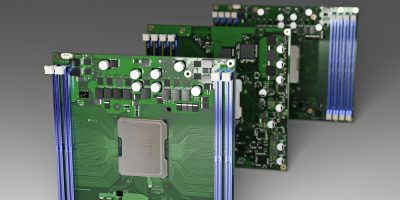congatec introduces five models for mixed-critical real time servers
Five modules in the compact (160 x 160mm) COM-HPC server Size D performance class extend congatec’s Intel Xeon D-2700 processor based server on module (SoM) portfolio.
The introductions are in response to industry demand for edge server performance in a small form factor that is rugged and outdoor capable, said congatec. For real time mixed-critical applications, they have 512Gbyte of DDR4 RAM at 2,933Mtransfers per second with four DRAM modules supported, compared to eight in the larger (200 x 160mm) COM-HPC server Size E modules modules. The benefit of limiting the RAM is that the modules take up less space, which reduces the required footprint by 20 per cent compared to Size E.
Target applications for the Intel Xeon D-2700 processor based COM-HPC modules are deeply embedded, space-constrained edge server deployments with high data throughput but less memory-intensive workloads. They are typically found in industrial IoT (IIoT) -networked real time environments of smart factories and critical infrastructures.
” Mixed-critical edge server applications don’t have to handle RAM-intensive server workloads. Rather, they need to host multiple real-time applications side-by-side and therefore require as many cores as possible,” explained Martin Danzer, head of product management at congatec.
“They also must meet the demands of industrial communications with many small message packets that need to be processed in real time. Again, memory is not as critical compared to database-driven web servers that are used by thousands of people in parallel. . . . However, saving space is also very important for them.”
Independent of the various SoM specifications, all congatec COM-HPC Server modules with Intel Xeon processors (formerly Ice Lake D) in Size E and Size D as well as the COM Express Type 7 form factor are suitable for real time micro server workloads in rugged environments and extended temperature ranges. The company announced improvements including up to 20 cores, up to 1Tbyte RAM, double throughput per PCIe lane to Gen 4 speeds, as well as up to 100GbE connectivity and TCC / TSN (time co-ordinated computing / time sensitive networking) support.
Target applications range from industrial workload consolidation servers for automation, robotics and medical backend imaging to outdoor servers for utilities and critical infrastructures – such as smart grids for oil, gas and electricity as well as rail and communication networks – and also include vision enabled applications such as autonomous vehicles and video infrastructures for safety and security.
The SoMs also “significantly extend” the lifecycle of next generation rugged edge server designs compared to common servers, with up to 10 year availability planned. For mission critical designs, they offer Intel Boot Guard, Intel Total Memory Encryption – Multi-Tenant (Intel TME-MT) and Intel Software Guard Extensions (Intel SGX). Artificial intelligence (AI) applications benefit from built-in hardware acceleration including AVX-512 and VNNI. They also integrate the Intel Resource Director Technology (Intel RDT) and support remote hardware management features.




